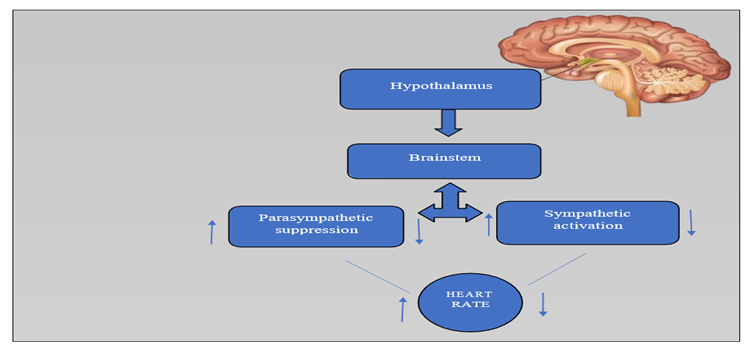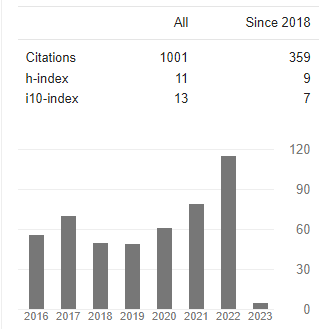APPLICABILITY OF HEART RATE VARIABILITY AS A CARDIAC-AUTONOMIC MARKER IN EXERCISE AND SPORTS SCIENCE
Abstract
Beat-to-beat variations in heart rate (HR) or variations in consecutive R-R intervals are usually described to be Heart Rate Variability (HRV). With the passage of time Heart Rate Variability comes out as an important clinical and investigational tool to provide insight into autonomous nervous tone. It is in point of fact that a wide variety of research works are being conducted on HRV. The present study presented an essence of the applicability of HRV in Exercise and Sports Science research. Available literatures which rendered and fulfilled the primary objective of this article were taken into consideration and reviewed and presented them systematically and interpreted with critical observations. The autonomic nervous system (ANS) regulates the cardio-vascular system with its neural control through the sympathetic & parasympathetic pathways. Analysis of HRV allows insight in this control mechanism. It can smoothly be detected from electrocardiogram (ECG) recordings, causing time series (R-R intervals) which are generally examined in time and frequency domains. Consequently, the HRV to be an important clinical and investigational tool is suggested to establish the role of exercise for wholesome betterment of athletes and practitioners.
Downloads
References
Boudoulas K. D., Paraskevaidis I. A., Boudoulas H., &Triposkiadis F. K. (2014). The left atrium: fromthe research laboratory to the clinic. Cardiology, 129(1), 1-17.
Rajendra Acharya U., Paul Joseph K., Kannathal N., Lim C. M., &Suri J. S. (2006). Heart rate
variability: a review. Medical and biological engineering and computing, 44(12), 1031-1051.
Dressendorfer R. H., Wade C. E., &ScaffJr J. H. (1985). Increased morning heart rate in runners: a valid sign of overtraining?. The Physician and Sportsmedicine, 13(8), 77-86.
Forte G., Favieri F., &Casagrande M. (2019). Heart rate variability and cognitive function: a systematic review. Frontiers in neuroscience, 13, 710.
Plews D. J., Laursen P. B., Stanley J., Kilding, A. E., &Buchheit, M. (2013). Training adaptation and heart rate variability in elite endurance athletes: opening the door to effective monitoring. Sports medicine, 43(9), 773-781.
Thayer J. F., Åhs F., Fredrikson M., Sollers III J. J., & Wager T. D. (2012). A meta-analysis of heart rate variability and neuroimaging studies: implications for heart rate variability as a marker of stress and health. Neuroscience &Biobehavioral Reviews, 36(2), 747-756.
Thayer J. F., Hansen A. L., Saus-Rose E., &Johnsen B. H. (2009). Heart rate variability, prefrontal neural function, and cognitive performance: the neurovisceral integration perspective on self-regulation, adaptation, and health. Annals of behavioral medicine, 37(2), 141-153.
Kiviniemi A. M., Hautala A. J., Kinnunen H., &Tulppo M. P. (2007). Endurance training guided
individually by daily heart rate variability measurements. European journal of applied physiology, 101(6), 743-751.
Da Silva D. F., Ferraro Z. M., Adamo K. B., & Machado F. A. (2019). Endurance running training
individually guided by HRV in untrained women. The Journal of Strength & Conditioning Research, 33(3), 736-746.
Javaloyes A., Sarabia J. M., Lamberts R. P., & Moya-Ramon M. (2019). Training prescription guided by heart-rate variability in cycling. International journal of sports physiology and performance, 14(1), 23-32.
Berntson G. G., Thomas Bigger Jr, J., Eckberg D. L., Grossman P., Kaufmann P. G., Malik M., ... & VAN DER MOLEN M. W. (1997). Heart rate variability: origins, methods, and interpretive caveats. Psychophysiology, 34(6), 623-648.
Billman G. E. (2011). Heart rate variability–a historical perspective. Frontiers in physiology, 2, 86.
Vanderlei L. C. M., Pastre C. M., Hoshi R. A., Carvalho T. D. D., & Godoy M. F. D. (2009). Basic
notions of heart rate variability and its clinical applicability. Brazilian Journal of Cardiovascular Surgery, 24(2), 205-217.
Aubert A. E., Seps B., &Beckers F. (2003). Heart rate variability in athletes. Sports medicine, 33(12),889- 919.
Catai A. M., Chacon-Mikahil M. P. T., Martinelli F. S., Forti V. A. M., Silva E., Golfetti R., ...& Gallo-Junior L. (2002). Effects of aerobic exercise training on heart rate variability during wakefulness.
Plews D. J., Laursen P. B., Kilding A. E., &Buchheit M. (2012). Heart rate variability in elite triathletes, is variation in variability the key to effective training? A case comparison. European journal of applied physiology, 112(11), 3729-3741.
Porges S. W. (1973). Heart rate variability: An autonomic correlate of reaction time performance. Bulletin of the Psychonomic Society, 1(4), 270-272.
Bonnemeier H., Wiegand U. K., Brandes A., Kluge N., Katus H. A., Richardt G., &Potratz J. (2003).Circadian profile of cardiac autonomic nervous modulation in healthy subjects: differing effects of aging and gender on heart rate variability. Journal of cardiovascular electrophysiology, 14(8), 791-799.
Buchheit M. (2014). Monitoring training status with HR measures: do all roads lead to Rome?. Frontiers in physiology, 5, 73.
Shaffer F., & Ginsberg J. P. (2017). An overview of heart rate variability metrics and norms. Frontiers in public health, 258.
Electrophysiology T. F. O. T. E. S. O. C. T. N. A. S. O. P. (1996). Heart rate variability: standards of measurement, physiological interpretation, and clinical use. Circulation, 93(5), 1043-1065.
Berntson G. G., Lozano D. L., & Chen Y. J. (2005). Filter properties of root mean square successive difference (RMSSD) for heart rate. Psychophysiology, 42(2), 246-252.
Penttilä J., Helminen A., Jartti T., Kuusela T., Huikuri H. V., Tulppo M. P., ... &Scheinin H. (2001). Time domain, geometrical and frequency domain analysis of cardiac vagal outflow: effects of various respiratory patterns. Clinical physiology, 21(3), 365-376.
Shusterman V. L. A. D. I. M. I. R., Anderson K. P., &Barnea O. F. E. R. (1997). Spontaneous skin temperature oscillations in normal human subjects. American Journal of Physiology-Regulatory, Integrative and Comparative Physiology, 273(3), R1173-R1181.
Vaschillo E., Lehrer P., Rishe N., &Konstantinov M. (2002). Heart rate variability biofeedback as a method for assessing baroreflex function: a preliminary study of resonance in the cardiovascular system. Applied psychophysiology and biofeedback, 27(1), 1-27.
Taylor J. A., Carr D. L., Myers C. W., &Eckberg D. L. (1998). Mechanisms underlying very-low-
frequency RR-interval oscillations in humans. Circulation, 98(6), 547-555.
Xhyheri B., Manfrini O., Mazzolini M., Pizzi C., &Bugiardini R. (2012). Heart rate variability today. Progress in cardiovascular diseases, 55(3), 321-331.
Voss A., Schulz S., Schroeder R., Baumert M., &Caminal P. (2009). Methods derived from nonlinear dynamics for analysing heart rate variability. Philosophical Transactions of the Royal Society A: Mathematical, Physical and Engineering Sciences, 367(1887), 277-296.
Chen Z., Brown E. N., &Barbieri R. (2010). Characterizing nonlinear heartbeat dynamics within a point process framework. IEEE Transactions on Biomedical Engineering, 57(6), 1335-1347.
Poon C. S., &Merrill C. K. (1997). Decrease of cardiac chaos in congestive heart failure. Nature, 389(6650), 492-495.
Braun C., Kowallik P., Freking A., Hadeler D., Kniffki K. D., &Meesmann M. (1998). Demonstration of nonlinear components in heart rate variability of healthy persons. American Journal of Physiology-Heart and Circulatory Physiology, 275(5), H1577-H1584.
Kleiger R. E., Stein P. K., & Bigger Jr J. T. (2005). Heart rate variability: measurement and clinical utility. Annals of Noninvasive Electrocardiology, 10(1), 88-101.
Lahiri M. K., Kannankeril P. J., & Goldberger J. J. (2008). Assessment of autonomic function in cardiovascular disease: physiological basis and prognostic implications. Journal of the American college of Cardiology, 51(18), 1725-1733.
Routledge F. S., Campbell T. S., McFetridge-Durdle J. A., & Bacon S. L. (2010). Improvements in heart rate variability with exercise therapy. Canadian Journal of Cardiology, 26(6), 303-312
Javaloyes A., Sarabia J. M., Lamberts R. P., Plews D., & Moya-Ramon M. (2020). Training prescription guided by heart rate variability vs. block periodization in well-trained cyclists. The Journal of Strength & Conditioning Research, 34(6), 1511-1518.
Di Fronso S., Delia G., Robazza C., Bortoli L., &Bertollo M. (2012). Relationship between performance and heart rate variability in amateur basketball players during playoffs. Sport Science and Health, 8, 45.
Peterson K. D. (2018). Resting heart rate variability can predict track and field sprint performance. OA Journal-Sports, 1(1).
Pojman, N., Behneman, A., Kintz, N., Johnson R., Chung G., Nagashima S., ... &Berka C. (2009, July).Characterizing the psychophysiological profile of expert and novice marksmen. In International Conference on Foundations of Augmented Cognition (pp. 524-532). Springer, Berlin, Heidelberg.
SHARMA, N. P., & SINGH, M. (2014). SENIOR AGE GROUP RELATIVE EXERCISES AND IMPACT ON THEIR LIFESTYLE. International Journal of Behavioral Social and Movement Sciences, 3(04), 78–82. Retrieved from https://ijobsms.org/index.php/ijobsms/article/view/246
CHAND PURI, P., MISHRA, P., JHAJHARIA, B., & SINGH, M. (2014). COORDINATIVE ABILITIES OF VOLLEYBALL IN DIFFERENT AGE GROUPS: A COMPARATIVE STUDY. International Journal of Behavioral Social and Movement Sciences, 3(3), 56–68. Retrieved from https://ijobsms.org/index.php/ijobsms/article/view/228
Ortega E., & Wang C. J. K. (2018). Pre-performance physiological state: Heart rate variability as a predictor of shooting performance. Applied psychophysiology and biofeedback, 43(1), 75-85.
Buchheit M., Racinais S., Bilsborough J. C., Bourdon P. C., Voss S. C., Hocking J., ... & Coutts A. J. (2013). Monitoring fitness, fatigue and running performance during a pre-season training camp in elite football players. Journal of science and medicine in sport, 16(6), 550-555.
Stanley J., Peake J. M., &Buchheit M. (2013). Cardiac parasympathetic reactivation following exercise: implications for training prescription. Sports medicine, 43(12), 1259-1277.
McLean B. D., Coutts A. J., Kelly V., McGuigan M. R., & Cormack S. J. (2010). Neuromuscular,
endocrine, and perceptual fatigue responses during different length between-match microcycles in professional rugby league players. International journal of sports physiology and performance, 5(3), 367-383.
Buchheit M., &Laursen P. B. (2013). High-intensity training, solutions to the programming puzzle. Part II: anaerobic energy, neuromuscular load and practical applications. Sports Med, 43(927), 54.

Copyright (c) 2023 Dilip Roy, Sridip Chatterjee

This work is licensed under a Creative Commons Attribution 4.0 International License.














